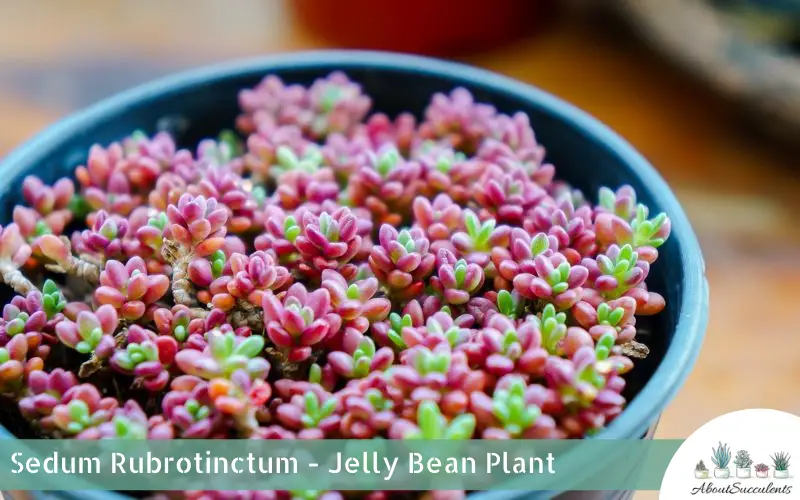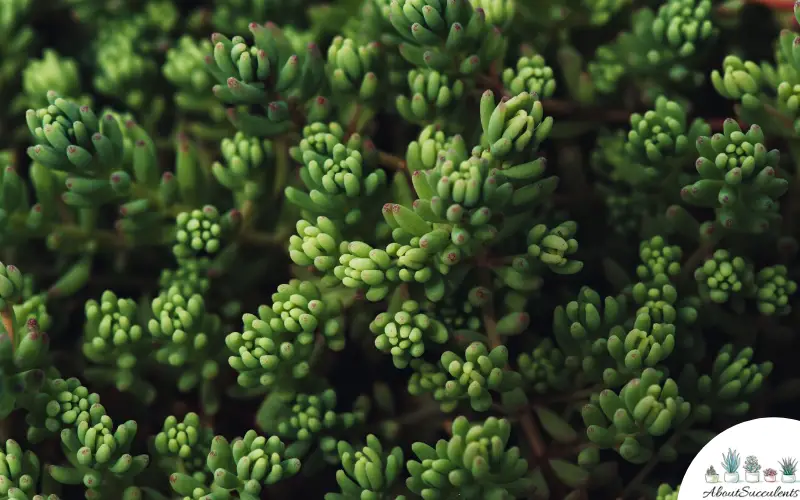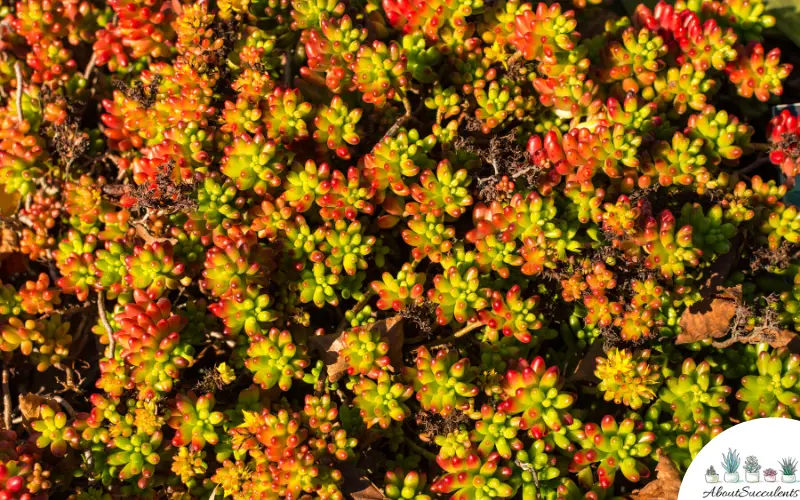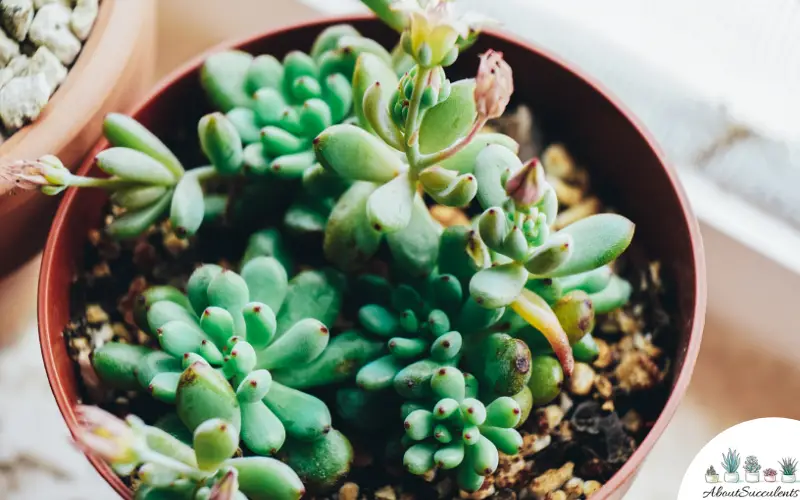
Sedum rubrotinctum is a colorful, fun-looking succulent that is a go-to plant for growers because they are very easy to grow and propagate. Its popular nickname is Jelly Bean Plant because of its leaves which have the shape of the jelly bean candy.
Jelly Bean Plant has green-colored leaves that develop red-colored tips when it gets full exposure to sunlight. In the springtime, this delightful succulent produces bright, star-shaped flowers which give it another nickname, “Christmas Cheer”.
Sedum rubrotinctum can grow up to 12-inches (30cm), is a member of the Crassulaceae family and is native to Mexico.
General Information:
Also known as: Jelly Beans, Christmas Cheer, Pork and Beans
Plant Family: Crassulaceae
Origin: Mexico
Height: 12-inches (30cm)
Exposure: Full to partial sunlight up to 6 hours per day
Water Needs: Light watering schedule during the summer months; very little to no watering in the winter or cold season.
Soil Type: Cactus soil or soil mix made of potting soil with equal parts perlite.
Soil pH: Acidic (7.0 to 8.5 pH)
Tolerance: Drought
How To Grow And Care For Sedum Rubrotinctum

Sedum rubrotinctum propagates very fast. Leaves that fall to the ground can take root rather quickly. This is why Sedum rubrotinctum is primarily used by growers as ground cover in an outdoor garden.
Although Jelly Bean Plant can be grown indoors, another reason for growing it outdoors is to get full sun exposure so that it can produce the red tips and beautiful flowers.
With its origins traced to Mexico, Jelly Bean Plant can withstand dry periods and warm conditions. It is not a cold-hardy plant. If you live in an area where the temperatures can fall below 20° F (-6.7° C), it would be best to grow Sedum rubrotinctum indoors.
1. Sunlight
Sedum rubrotinctum’s appearance will change depending on its exposure to sunlight.
Jelly Bean Plant that is grown outdoors and given full to partial sun exposure of up to 6 hours develop the reddish hue on the leaves because this is a substance that protects the plant from sunburn.
On particularly hot days, the succulent can still be scorched from the sun rays and should be moved to partially shaded areas.
Jelly Bean Plant that is grown indoors will develop the leaves with the deep green colors that have associated the succulent with the Christmas season.
When grown indoors, place the pot near a window that receives a small amount of direct sunlight.

2. Watering
Sedum rubrotinctum can survive without water for a long period. Do not worry if you haven’t watered the plant for more than a week.
Overwatering can harm the plant by causing its roots to rot. Jelly Bean should only receive water when its soil has completely dried out.
To know for sure if it’s time to water Sedum rubrotinctum, insert a BBQ stick a few inches into the soil. If the stick comes out wet, do not give the plant water.
If the stick comes out dry, then it is safe to water Jelly Bean Plant.
Water the plant sparingly, if ever at all, during the winter or cold season. The soil will stay moist longer and following a similar watering schedule as you would for spring and summer would lead to overwatering.
3. Pot and Soil
Plant Sedum rubrotinctum in a pot that has good drainage. It should have enough space to allow the plant to take root without affecting the level of air circulation. If the succulent has outgrown the pot, remove the plant and transfer it to a new pot with fresh potting soil.
You can buy commercially available potting mix with well-draining properties such as cactus soil. You can add perlite to improve its draining properties. The ideal ratio is one part cactus mix to one part perlite.
If Jelly Bean Plant does not appear to be growing properly, give it fertilizer that is diluted by water to reduce its strength by ¼ of the recommended dosage. It would be best to give the succulent fertilizer only during the spring months.
How To Propagate Sedum Rubrotinctum

Sedum rubrotinctum is a type of succulent that you won’t have a hard time propagating. There are 2 methods for propagating Jelly Bean Plant: Leaves and Cuttings.
1. Leaves Method
Step 1 – Gently remove a leaf by twisting it off the stem. Make sure you perform a “clean pull” whereby there is no part of the leaf that is left on the stem.
Step 2 – Place the leaf in a dry and shaded area to allow it to develop calluses.
Step 3 – Place the callused leaf on a pot filled with well-draining soil.
2. Cuttings Method
Step 1 – Remove a stem from the main plant by using a pair of sharpened and sterilized garden shears or scissors.
Step 2 – Allow the stem to develop calluses. This process may take several days.
Step 3 – Plant the cuttings on well-draining soil and give it water whenever the soil has dried out.
Frequently Asked Questions
Is Sedum Rubrotinctum Toxic for Cats and Dogs?
Sedum rubrotinctum does not appear in the list of plants that are toxic for cats and dogs on the website of the American Society for the Prevention of Cruelty to Animals (ASPCA).
The list is only partial which means it does not cover every single succulent plant. If you notice your pet with the following symptoms: vomiting and gastrointestinal distress, bring the pet right away to a Veterinarian.
Why is my Sedum Rubrotinctum Succulent Dying?
Sedum rubrotinctum is a resilient succulent. If you notice Jelly Bean Plant getting weaker, shriveling, with signs of deterioration, it could be dying.
There are 3 potential threats to Jelly Bean Plant’s health: Overwatering and underexposure to the sun.
1. Overwatering
Giving Sedum rubrotinctum too much water will lead to root rot which can rapidly spread throughout the succulent plant. When watering, do not water the leaves. Instead, water the soil.
If you are growing Jelly Bean Plant indoors, discard the excess water that has accumulated in the tray underneath the pot. Excess water will immerse the roots in moisture longer than they should.
A sign of root rot is discoloration. If you see any part of the plant turning brown or blackish, remove the section right away with a sharp and sterilized knife.
Then, gently remove Jelly Bean Plant from the soil. Allow the roots to dry out properly and cut off its rotted parts. Once the plant has dried out, re-plant it in a pot with fresh, well-draining soil.
2. Underexposure to the Sun
Similar to succulents from the Crassulaceae family, Sedum rubrotinctum needs the sun.
Underexposure can cause the leaves to turn yellowish-green instead of the reddish hue it is known for.
If this happens, the leaves will slowly rot out and infect the rest of the plant. Upon noticing signs of discoloration, transfer Jelly Bean Plant to a location that receives more sunlight.
Does Sedum Rubrotinctum Produce Flowers?
Yes, Sedum rubrotinctum produces flowers in the spring. The flowers have a yellow color and do not have fragrance.
For Jelly Bean Plant to bloom, it must receive full or partial exposure to sunlight on a regular basis. This is another reason why the succulent is best grown outdoors.
Last Updated on June 10, 2022 by Sofia Lara